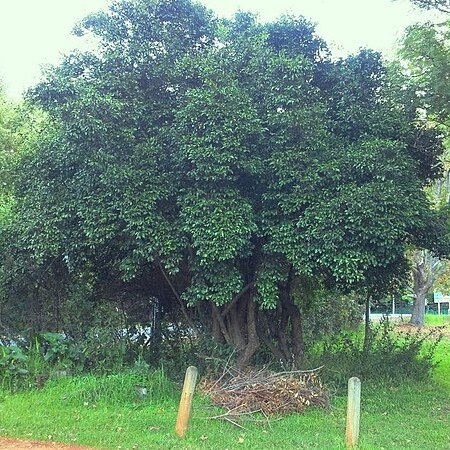A shrub or tree. It can grow 10 m high. The bark is dark grey and smooth. The branches are upright. They are waxy with wrinkles long their length and armed with spines. The leaves are oblong and 2.5-7.5 cm long by 1-3.8 cm wide. They have a thin texture. They are light green above and paler underneath. The edges are rolled under. The leaf stalk is 8-12 mm long. The flowers are very small and greenish. They have a slight scent. The flowers occur in many branched heads in the axils of leaves. These are 1.5-3 cm across. The fruit are oval and 1.3 cm long. They are dark brown when mature. They are slightly wrinkled.
Leaves restricted to new growth at apex of stems, not usually fully mature at time of flowering; blades 3–10 × 1.3–4.5 cm, narrowly to broadly elliptic, obtuse to acute or subacuminate at apex, usually cuneate at base, papery, often discolorous, drying brownish above and glaucous green beneath; lateral nerves in 4 main pairs; tertiary nerves apparent, at least near the margin; domatia glabrous to pubescent; petioles 5–13 mm long; stipules 2–4 mm long, shortly sheathing then broadly triangular, usuallyapiculate, with dense white hairs inside.
Perennial tree or shrub, 1-7 m high. Leaves elliptic, softly leathery, glabrous, glossy above, domatia with or without hairs, apex subacuminate, margins wavy; petioles up to 12 mm long; stipules triangular, 2-4 mm long. Flowers in axillary cymes; peduncle up to 7 mm long; pedicels 3-7 mm long. Calyx 1.00-1.25 mm long, glabrous. Corolla cream-coloured to yellowish; tube 2-3 mm long. Ovary: style short, exserted. Flowering time Oct.-Jan. Fruit oblong-ovoid, ± 15 x 10 mm, dark brown; pyrene rugulose.
Small tree or shrub, up to 5 m high. Branches spiny. Leaves ovate to ovate-oblong, glabrous, discolorous. Inflorescence 10-20-flowered. Corolla throat villous. Flowers greenish.
Pyrene 12–13 × 4–5 mm, ellipsoid with ventral face flattened or oblong-ellipsoid, with a crest along the ventral face above the truncate point of attachment, rugulose.
Flowers 5-merous; borne in shortly pedunculate 4–40-flowered cymes with rather reduced branches; peduncles 0.5–5(7) mm long, glabrous; pedicels 3–7 mm long, glabrous.
Shrub or tree 1–10(14) m tall, occasionally said to be scandent, often armed with paired supra-axillary spines, glabrous; bark light grey to fawn-coloured.
Usually thorny shrub or tree to 10 m. Leaves opposite, elliptic. Flowers several in axillary cymes, whitish, corolla bearded.
Corolla cream to yellowish; tube 2–3 mm long, pubescent at throat; lobes 2–3 × 1–2 mm, triangular to ovate, acute.
Calyx tube 1–1.25 mm long, glabrous; limb a dentate rim scarcely equalling the disk.
Fruit 12–15 × 9–10 mm, narrowly oblong-ovoid, scarcely bilobed or indented.
Style shortly but distinctly exserted.
Pollen presenter 0.75–1 × 0.75–1 mm.


